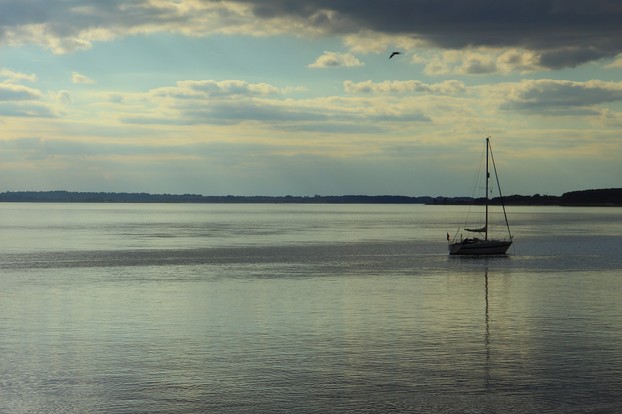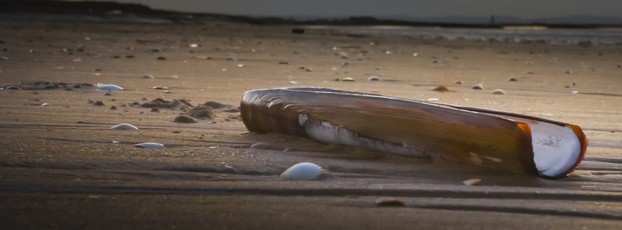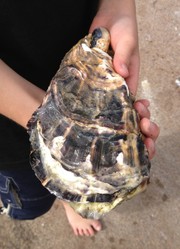The reason for having oysters is that they are filter feeders. As they open and close their shells each oyster can filter 100 litres of water a day and digest edible material in the water, rendering it into edible oyster flesh and purifying the waters. .What is more, they breed, and thus the three thousand oysters from Loch Ryan will become many more; and more oysters means more filtering. It also means a renewal of the lost shellfish industry in the Humber, something much needed at a time when fisheries in Britain are under threat from over-exploitation.
Of course oysters alone are insufficient. The waters that flow from the rivers of Yorkshire and its southerly neighbour Lincolnshire were subject to water purification treatments and restrictions on the industrial pollution of water. This pollution has so blighted this isle for two hundred years and had to be stopped and reversed. The oyster beds are one later stage in a long process of repair.
The beds are carefully sited to give the oysters maximum chance to thrive, and moreover the oysters are confined to cages attached firmly to the sea bed to prevent their being swept away by the strong currents that scour the area. But their spawn will flow free out through the mesh of the cages, restocking the coastal area.
But oysters are not the only shellfish being introduced to the new fishery. Bouchot mussels, also filter feeders, are arriving from Brittany from near Mont Saint Michel, where they are cultivated and are known to produce a highly delicious flesh.
The cultivation technique is to stretch out a line of poles from the shore, which ropes are stretched, propylene being the favoured material. The rope are seeded with mussel spawn. At the foot of each pole there is an inverted cone to prevent crabs from climbing up to take the mussels. Harvest involves pulling the mussels off the ropes, often by machine. Further protection is given by draping netting over the mussels, which deters and prevents predators even more. Once the mussels are sown this is an easy fishery, for the mussels seed themselves every year,as long as you do not take the lot of them.
Other filter feeders being introduced are razor clams. These are commoner in West Britain than in the east. They dwell in sandy beaches and are perfectly edible. They are being introduced to the sandy beaches of Spurn Island, a south-pointing spit that was recently sundered from the mainland by a storm. It houses Britain's only full time lifeboat crew.
Humankind damaged nature and it seems that it needs to harness nature to solve the problems that neglect of nature has created. This is one small ecological step in the creation of a greener world.






 Pilgrimage. A reviewon 06/15/2025
Pilgrimage. A reviewon 06/15/2025
 Leo the Fourteenthon 05/09/2025
Leo the Fourteenthon 05/09/2025
 The Melsonby Hoardon 03/25/2025
The Melsonby Hoardon 03/25/2025


Comments
We rarely eat oyster soup, but oysters are cooked and served in their shells.
The film The menu with Ralph Fiennes in the title role begins a gourmet experience with non-soupy oyster appetizers.
Many Unitedstatesians correlate oyster consumption with oyster soup.
Do British Isles-ers do likewise? Or does some other preparation draw them?
Thank you for your comment below, on Jul 11, 2022, in answer to my previous observation and question.
That "non-native oysters are eaten" intrigues me.
Is there a particular world area that sources such oysters for British Isles-ers?
Non-native oysters are eaten, but not sown, which facilitates their dying out.
You indicate, under your first subheading Oysters from Loch Ryan, that "Passengers on the regular ferries that steam out of Loch Ryan on their way to Belfast will be accustomed to seeing the oyster boats near the eastern shores of the loch quietly going about their business. But they would not have noticed the team of scientists with the crew ensuring that all the oysters were native species, a task rendered necessary by the ubiquitous presence of the invasive Pacific oyster, which came to Britain via ships coming from New Zealand, liked what it found and stayed. The ecologists were determined that they would only sow native oysters, so care was needed."
What is the plan of "ensuring that all the oysters were native species" involving? Would the scientists offer non-native oysters to oyster businesses and business-people, relocate them, study them...?
Each! When they are submerged they constantly open and shut their shells, so the amount of water flowing through each one is enormous.
Oysters filter 100 liters of water a day?! :)
There has been discussion at European level on mercury pollution, so there my be some, but Britain has strong laws on the release of toxic substances into the environment. Furthermore, the Ministry for Agriculture, Food and Fisheries make regular checks on shellfish, and would warn us if there were any danger, and there have been no government alerts about mercury.
The Zebra mussel is a problem here as well. It has taken residence in water treatment works, where it blocks pipes.
The bouchot mussels come from France, so they are from the same ecological area as Britain, so we expect no problems.
Frank, does the pollution include mercury from industry? Here, mercury is a problem. Once consumed it is a cumulative toxin, which means it stays and adds to what is consumed next. That is why our fish are high in mercury. I assume oysters would also accumulate toxins like mercury if it passed through them.
Farther north in the Great Lakes region there is concern over a zebra mussel, which arrived by ship. It is not native to the area, and multiplies so quickly pipes became clogged. Hence, it is wise to only use native species.
Bouchot mussels are a delicacy.I think that they are a subspecies of mussel related to other kind of mussel found locally. It is too early to know the impact of water shortage in the future.